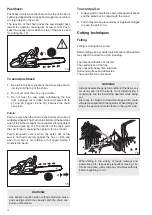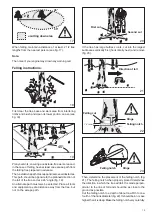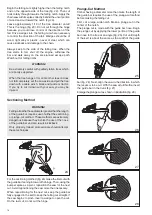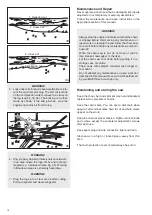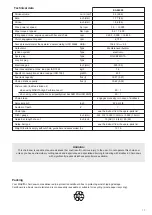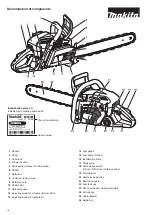
4
Additional safety precautions
The following additional safety precautions must be ob-
served by all users of chain saws:
- A chain saw is intended for two-handed use. Do not
operate a chain saw with one hand! Serious injury to
the operator, helpers, bystanders may result from one-
handed operation.
- When a chain saw is being used, a fire extinguisher
should be available.
- Follow the instructions in your operator’s manual for
starting the chain saw and control the chain saw with a
firm grip on both handles when it is in operation. Keep
handles dry, clean, and free of oil or fuel mixture.
- Do not operate a chain saw when you are fatigued.
Fatigue causes carelessness. Be more cautious before
rest periods and towards the end of your shift.
- Personal protective clothing required by your safety
organizations, government regulations, or your employer
should be used. At all times when using a chain saw,
snug-fitting clothing, protective eyewear, safety footwear,
and hand, leg, head and hearing protection should be
worn.
Note: Personal protective clothing should meet the
requirements of applicable CSA and BNQ Standards.
- Use caution when handling fuel. Before fuelling, ser-
vicing, or transporting your chain saw, switch off the
engine. To help prevent fire, restart your chain saw at
least 3 m (10 ft) from the fuelling area.
- Keep other persons or animals a safe distance away
from a running chain saw or the area where a tree is
being felled.
- Always keep proper footing and operate the chain saw
only when standing on a fixed, secure, and level surface,
and a planned retreat path from the falling tree.
- Keep all parts of your body away from the saw chain
when the engine is running.
- Before you start the engine, make sure that the saw
chain is not contacting anything.
- Carry the chain saw by the front handle with the engine
stopped, the guide bar and saw chain to the rear, and
the muffler away from your body.
- When transporting, storing or not in use, always use the
appropriate guide bar cover. It must fit and fully cover
the guide bar on the chain saw.
- Never operate a chain saw that is damaged or impro-
perly adjusted or that is not completely and securely
assembled. Be sure that the saw chain stops moving
when the power control system trigger is released. Never
adjust the guide bar or saw chain when the engine is
operating.
- Shut off the engine before setting the chain saw down.
- Use extreme caution when cutting small-size brush
and saplings because slender material may catch the
saw chain and be whipped toward you or pull you off
balance.
Safety precautions for chain saw operators
While operating the chain saw please observe the follo-
wing rules:
a)
Contact of the guide bar nose with any object
should be avoided.
b)
Tip contact may cause the guide bar to move
suddenly upward and backward, which may
cause serious or fatal injury.
WARNING!
Read and follow all safety precautions in the operator’s
manual. Failure to follow instructions could result in
serious injury. It is recommended to lend the chain
saw only to people who are experienced in working
with chain saws. Always hand over the Operator’s
and Safety Manual.
WARNING!
This chain saw is capable of severe kickback that
could result in serious injury to the operator. Do not
operate this chain saw unless you have extraordinary
cutting needs and experience in and special training
for dealing with kickback.
Chain saws with significantly reduced kickback po
-
tential are available.
Kickback safety precautions
WARNING!
Kickback may occur when the nose or tip of the guide
bar touches an object, or when the wood closes in and
pinches the saw chain in the cut. Tip contact in some
cases may cause a lightning-fast reverse reaction,
kicking the guide bar up and back toward the opera-
tor. Pinching the saw chain along the top of the guide
bar may push the guide bar rapidly back toward the
operator. Either of these reactions may cause you to
lose control of the saw, which could result in serious
personal injury. Do not rely exclusively upon the safety
devices built into your saw. As a chainsaw user, you
should take several steps to keep your cutting jobs
free from accident or injury.
a) With a basic understanding of kickback, you
can reduce or eliminate the element of surprise.
Sudden surprise contributes to accidents.
b) Keep a good firm grip on the saw with both
hands, the right hand on the rear handle and the
left hand on the front handle, when the engine is
running. Use a firm grip with thumbs and fingers
encircling the chain saw handles. A firm grip will
help reduce kickback and maintain control of the
saw. Don‘t let go.
c) Make sure that the area in which you are cutting
is free from obstructions. Do not let the nose
of the guide bar contact a log, branch, or any
other obstruction that could be hit while you are
operating the saw.
d) Cut at high engine speeds.
e) Do not overreach or cut above shoulder height.
f) Follow the manufacturer’s sharpening and main
-
tenance instructions for the saw chain.
g) Only use replacement bars and chains specified
by the manufacturer or the equivalent.























